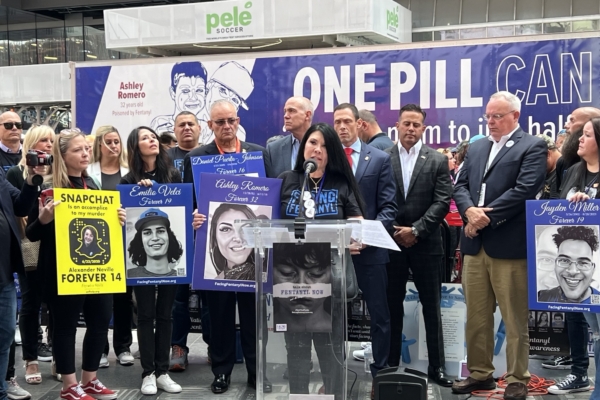In a report released by the UCLA Health Center in January 2024, it was revealed that in 2022, an average of 22 teenagers aged 14 to 18 died from drug overdoses in the United States every week. This alarming statistic has raised the mortality rate in this young age group to 5.2 deaths per 100,000 individuals. What could possibly tempt these youths in their prime to leave this world prematurely?
On August 21, the nonprofit organization “Facing Fentanyl,” composed of families of victims, held the third annual “National Fentanyl Prevention and Awareness Day” in Manhattan, New York. Andrea Thomas, the founder of the organization, pointed out that “dealers are exploiting social media platforms to make dangerous drugs more accessible to our young people.”
One parent shared a heartbreaking story at the event, stating, “In the summer of 2020, I lost my 14-year-old son, Alexander, because he made contact with a drug dealer on Snapchat.”
The mother, Amy Neville, mentioned that the dealer posted a drug menu on Snapchat, engaged in conversation with her son Alexander, obtained their home address, and delivered the drugs to her son like a pizza delivery driver.
“All of this happened while we were asleep,” she said. About 10 days after the first transaction, her 14-year-old son passed away after ingesting a pill purchased from a dealer online through Snapchat.
Amy expressed that drug crimes appearing on Snapchat and other social media platforms are still rampant. Law enforcement dubbed Snapchat as “the Wild West,” and young people she spoke to mentioned that Snapchat is the easiest place to find drugs.
Having worked in combating drug crimes for over twenty years, Frank A. Tarentino, head of the DEA New York Division, highlighted the alarming data on the drug crisis. In 2022, 3,026 people died from drug overdoses or poisonings in New York City, with over 110,000 deaths nationwide linked to the drug crisis, and more than 70% attributed to fentanyl.
Notably, drug overdoses and poisonings have become the leading causes of death among Americans aged 18 to 45, surpassing deaths from accidents, firearms violence, and suicide. Tarentino emphasized that, on average, two Americans die from drug overdoses or poisonings every 10 minutes.
Tarentino stated that the DEA has set three top priorities, one of which is combating drug trafficking organizations, with a particular focus on Mexican drug cartels responsible for manufacturing, transporting, and distributing fentanyl and methamphetamine (also known as meth).
Currently, the DEA has conducted operations in all 50 states in the US and over fifty countries globally, leading to arrests and prosecution of notorious drug cartel leaders and drug crime syndicates from China.
Last month, Mexico’s major drug lord Ismael “El Mayo” Zambada and his former associate, known as “El Chapo” Guzmán’s son, were arrested in Texas.
Furthermore, the DEA is targeting drug dealers and street traffickers, especially those hiding behind social media. In 2023, US law enforcement seized over 115 million illegal fentanyl pills, contrasting with around 50,000 in 2017, marking a 2,300-fold increase.
However, Tarentino highlighted that the primary source of fentanyl drug ingredients is mainly from China.
In April, the US House of Representatives released a 64-page report revealing that China directly subsidizes the production and export of fentanyl precursors and owns ownership stakes in several Chinese companies linked to illegal drug trafficking.
The widespread use of social media and the internet has become an indispensable source of information for young people, but for adolescents lacking discernment, resisting the lure of drug trafficking on the internet is even more challenging than for adults. Amy called for legislative measures to restrain social media’s facilitation of drug trafficking, addressing the legal loopholes that allow minors access to drugs.
“Social media has become the final frontier of drug distribution networks,” she pointed out, stressing that a legal loophole is the lack of legal obligation for social media companies to report drug dealers to law enforcement.
As the lead plaintiff, Amy has filed a lawsuit against Snapchat (Neville et al v. Snap, Inc.), which has progressed to the evidence submission stage. According to the lawsuit, Amy’s son ingested a hydrocodone pill containing fentanyl.
Amy mentioned that Congress is reintroducing a bill aimed at preventing drug crimes targeting teenagers. She urged people to contact their congressional representatives to push for the swift passage of the “Kids Online Safety Act” (S.1409-KOSA) to use legislation to restrain online drug trafficking and protect minors’ lives.
“The pain of losing a loved one is indescribable, it is a wound that will never heal,” stated Andrea Thomas, the founder of “Facing Fentanyl” who experienced the agony of losing a daughter, emphasizing that this profound pain drives her to strongly advocate for helping others avoid similar suffering.
Larry Lamendola from Long Island, New York, also endured such anguish. His daughter became addicted to drugs in her twenties and despite undergoing six rehabilitation treatments and striving to overcome addiction, she succumbed to the temptation of drugs.
“Unfortunately, I found her in her room, overdosed on drugs,” Lamendola told the press. His 25-year-old daughter’s death made him realize the need to take preventive actions to prevent similar tragedies from recurring.
He joined the organization named the “Levittown Community Action Coalition” as the co-chair and advisory council member. The organization collaborates closely with the local community, focusing on drug prevention education.
Lamendola believes that solely relying on border control to combat drugs is insufficient, emphasizing the necessity for education starting from childhood. To advocate for including drug prevention education in school curricula, he met with the New York Governor to push for legislation called “Chelsea’s Law,” inspired by California’s approach.
“California is leading in this regard,” he said. “Children from kindergarten to high school seniors are required to incorporate drug prevention education into the curriculum, which is what New York State also needs to do.”

